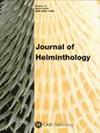Community structure of helminth parasites of the tuna, Euthynnus affinis, from the Visakhapatnam coast, Bay of Bengal
IF 1.3
3区 生物学
Q4 PARASITOLOGY
引用次数: 0
Abstract
An analysis is made of the community structure of the helminth parasites of the tuna孟加拉湾维萨卡帕特南海岸金枪鱼螺旋体寄生虫的群落结构
本文分析了在孟加拉湾维萨卡帕特南沿海采集的金枪鱼(Euthynnus affinis)螺旋体寄生虫的群落结构。螺旋体动物群由 23 个物种组成,包括 2 个单体虫、18 个双体虫、1 个幼虫绦虫、1 个线虫和 1 个棘头虫。寄生虫中最主要的是双鞭毛虫,有 14 种。寄生虫群的特点是物种丰富、多样性高。所发现的大多数寄生虫,尤其是双鞭毛虫类,都是寄主专科寄生虫,表现出高度的寄主专一性。动物群由三个核心物种、四个卫星物种和许多次要物种组成,它们之间没有相互作用的可能性,但可预测性很高,因为每个次群落都由两三个核心物种和几个次要物种叠加而成。许多宿主因素,如食物多样、嗜食性强、寿命长和内温性等,似乎促成了金枪鱼寄生虫群落物种丰富和多样化的发展。有证据表明,随着宿主体型的增加,寄生虫密度会降低,多样性会增加,这表明宿主体型对群落结构有着深远的影响。
本文章由计算机程序翻译,如有差异,请以英文原文为准。
求助全文
约1分钟内获得全文
求助全文
来源期刊

Journal of Helminthology
生物-动物学
CiteScore
2.80
自引率
12.50%
发文量
127
审稿时长
3 months
期刊介绍:
Journal of Helminthology publishes original papers and review articles on all aspects of pure and applied helminthology, particularly those helminth parasites of environmental health, medical or veterinary importance. Research papers on helminths in wildlife hosts, including plant and insect parasites, are also published along with taxonomic papers contributing to the systematics of a group. The journal will be of interest to academics and researchers involved in the fields of human and veterinary parasitology, public health, microbiology, ecology and biochemistry.
 求助内容:
求助内容: 应助结果提醒方式:
应助结果提醒方式:


